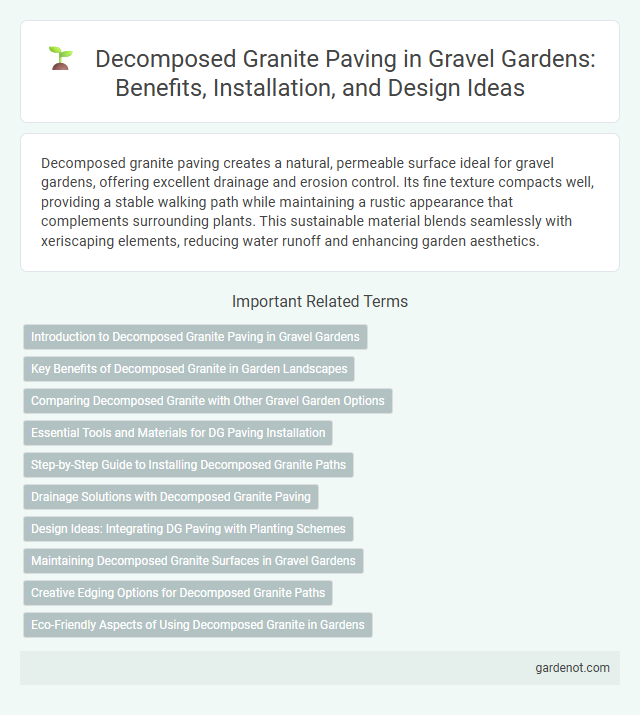Decomposed granite paving creates a natural, permeable surface ideal for gravel gardens, offering excellent drainage and erosion control. Its fine texture compacts well, providing a stable walking path while maintaining a rustic appearance that complements surrounding plants. This sustainable material blends seamlessly with xeriscaping elements, reducing water runoff and enhancing garden aesthetics.
Introduction to Decomposed Granite Paving in Gravel Gardens
Decomposed granite paving offers a natural, porous surface ideal for gravel gardens, enhancing drainage while providing a stable walking path. This material consists of finely crushed granite that compacts into a firm yet permeable base, perfect for sustainable landscaping. Its earthy texture blends seamlessly with plants and rocks, making decomposed granite a popular choice for eco-friendly garden design.
Key Benefits of Decomposed Granite in Garden Landscapes
Decomposed granite paving offers exceptional permeability, reducing water runoff and promoting soil health in garden landscapes. Its natural, fine texture provides a stable, slip-resistant surface ideal for pathways and patios. The material's eco-friendly composition and low maintenance requirements enhance garden sustainability and aesthetic appeal.
Comparing Decomposed Granite with Other Gravel Garden Options
Decomposed granite paving offers a smoother, more compact surface compared to traditional crushed stone or pea gravel, making it ideal for gravel garden pathways and patios. Its fine particles bind together naturally, reducing erosion and weed growth better than loose gravel options. Unlike gravel types that shift easily underfoot, decomposed granite provides enhanced stability and a cleaner aesthetic for low-maintenance garden designs.
Essential Tools and Materials for DG Paving Installation
Decomposed granite paving requires essential tools such as a plate compactor, rubber mallet, landscape fabric, and a garden rake for proper installation and leveling. Key materials include decomposed granite aggregate, stabilizer to prevent erosion, and edging stones to maintain pathway shape. Using these tools and materials ensures a durable, aesthetically pleasing gravel garden paving.
Step-by-Step Guide to Installing Decomposed Granite Paths
Decomposed granite paving offers a durable and natural-looking surface ideal for gravel gardens. Begin by excavating the pathway area to a depth of 4-6 inches and installing a weed barrier fabric to prevent growth. Next, compact a base layer of crushed rock, add a 2-3 inch layer of decomposed granite, and thoroughly compact it to create a stable, permeable path surface.
Drainage Solutions with Decomposed Granite Paving
Decomposed granite paving offers superior drainage solutions by allowing water to permeate through its porous structure, reducing runoff and preventing erosion in gravel gardens. This material's natural composition facilitates efficient water absorption, promoting healthy soil moisture levels and minimizing puddling. Properly installed decomposed granite pathways enhance garden longevity by maintaining stable drainage patterns and supporting sustainable landscape design.
Design Ideas: Integrating DG Paving with Planting Schemes
Decomposed granite paving enhances gravel gardens by offering a natural, permeable surface that complements diverse planting schemes such as drought-tolerant succulents, native grasses, and flowering perennials. Combining DG paving with layered plant textures creates dynamic visual contrast while supporting sustainable water management through improved drainage. Strategic edging with native stone or metal borders maintains clean lines and prevents gravel migration, ensuring long-term design cohesion in garden layouts.
Maintaining Decomposed Granite Surfaces in Gravel Gardens
Maintaining decomposed granite surfaces in gravel gardens involves regular raking to prevent compaction and promote drainage, ensuring the garden remains aesthetically pleasing and functional. Applying a stabilizer or resin binder can reduce erosion and dust while enhancing surface durability against foot traffic and weather conditions. Periodic replenishment of the decomposed granite layer helps maintain an even and stable surface, preventing weeds and soil degradation in the garden.
Creative Edging Options for Decomposed Granite Paths
Creative edging options for decomposed granite paths enhance both functionality and aesthetic appeal in gravel gardens. Materials such as steel, brick, and natural stone create clean, defined borders that prevent erosion and maintain path integrity. Incorporating reclaimed wood or decorative gravel borders also adds texture contrast while complementing the garden's natural theme.
Eco-Friendly Aspects of Using Decomposed Granite in Gardens
Decomposed granite paving in gravel gardens offers an eco-friendly solution by promoting natural water permeability, reducing runoff and supporting soil health. This sustainable material is derived from weathered granite, requiring minimal processing and lowering carbon footprints compared to concrete or asphalt. Its ability to naturally blend with the surrounding environment enhances local biodiversity and reduces heat absorption in garden landscapes.
Decomposed granite paving Infographic

 gardenot.com
gardenot.com